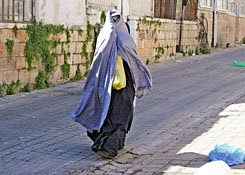Dressing to Greet the King?* (*Nablopomo Day#12)
I just read a guest post by E. Fink on DovBear about Black Hats (capitals intended) being like kugel. He says (as he states, partially tongue-and-cheekly) that it, like kugel, is a social phenomenon, not a religious one.
I tend to agree, and although I am not going in depth (with links and hours of research) into this here, I do want to say something about it. A Black Hat (and shtreimel for that matter) or kapote or bekishe is more reminiscent of 17th century Polish dress (and Jewish dress at that time) which means it is cultural in nature. Just as we in the twenty-first century in the West dress (men, specifically) in pants and shirt/jacket, most men in that era wore long coats (often over knickers, long socks and blousy shirts which some Hassidic sects wear today) and warm hats, appropriate for the cold climate of Eastern Europe, but not so for their Sephardic and transplanted Ashkenazic brethren in the Middle East.
Somehow or other, Hassidic sects fixated on a cultural dress of two-hundred years ago in Eastern Europe, where Hassidism was born, but the mode of dress never evolved.
This type of dress has also developed a 'religious significance' over the years. The explanation which I have heard is that 'we don our jackets and our hats (or our kapotes or bekishes) before saying kiddush (or benching or davening--fill in the blank) out of respect for our King.'
The implication is that if you don't, you are 1) not respectful, or 2) not religious. If nothing else, one is made to feel--intentionally or not--embarrassed at 'not doing it right.'
Is this telling me that the Israelis, who might be wearing a short-sleeved shirt and sandals when in shul or saying kiddush at home are not respectful or religious?
In essence, it boils down to this: how one dresses is really a cultural phenomenon; in cold climates, dark colors, long coats and fur hats are worn. In hot climates such as in Israel, light colors or white, short sleeves (and sometimes pants as well) are more appropriate, and should be worn.
That's it! It's logical. And what the black-hatters-and-bekishe-wearers are doing in the Israeli boiling-hot summers, is not.

*Copyright alert: No infringement of any text or graphic copyright is ever intended on this blog. If you own the copyright to any original image or document used for the creation of the graphics or information on this site, please contact the blog administrator with all pertinent info so that proper credit can be given. If you wish to have it removed from the site, just say the word; it shall be, ASAP.
I tend to agree, and although I am not going in depth (with links and hours of research) into this here, I do want to say something about it. A Black Hat (and shtreimel for that matter) or kapote or bekishe is more reminiscent of 17th century Polish dress (and Jewish dress at that time) which means it is cultural in nature. Just as we in the twenty-first century in the West dress (men, specifically) in pants and shirt/jacket, most men in that era wore long coats (often over knickers, long socks and blousy shirts which some Hassidic sects wear today) and warm hats, appropriate for the cold climate of Eastern Europe, but not so for their Sephardic and transplanted Ashkenazic brethren in the Middle East.
Somehow or other, Hassidic sects fixated on a cultural dress of two-hundred years ago in Eastern Europe, where Hassidism was born, but the mode of dress never evolved.
This type of dress has also developed a 'religious significance' over the years. The explanation which I have heard is that 'we don our jackets and our hats (or our kapotes or bekishes) before saying kiddush (or benching or davening--fill in the blank) out of respect for our King.'
The implication is that if you don't, you are 1) not respectful, or 2) not religious. If nothing else, one is made to feel--intentionally or not--embarrassed at 'not doing it right.'
Is this telling me that the Israelis, who might be wearing a short-sleeved shirt and sandals when in shul or saying kiddush at home are not respectful or religious?
In essence, it boils down to this: how one dresses is really a cultural phenomenon; in cold climates, dark colors, long coats and fur hats are worn. In hot climates such as in Israel, light colors or white, short sleeves (and sometimes pants as well) are more appropriate, and should be worn.
That's it! It's logical. And what the black-hatters-and-bekishe-wearers are doing in the Israeli boiling-hot summers, is not.

*Copyright alert: No infringement of any text or graphic copyright is ever intended on this blog. If you own the copyright to any original image or document used for the creation of the graphics or information on this site, please contact the blog administrator with all pertinent info so that proper credit can be given. If you wish to have it removed from the site, just say the word; it shall be, ASAP.

Comments
But to modify it for the summers in Israel (and Monsey, for that matter) would, I think, be wise...
(Maybe a white bekeshe and white cotton hat?!)